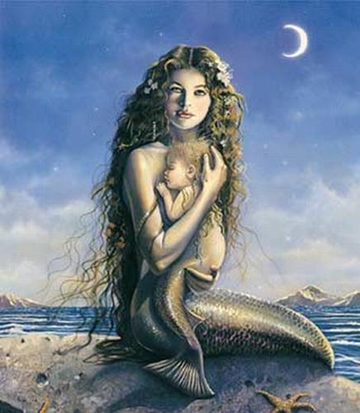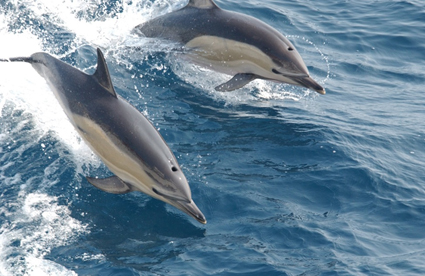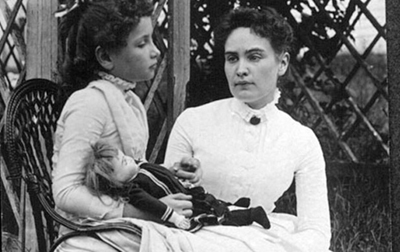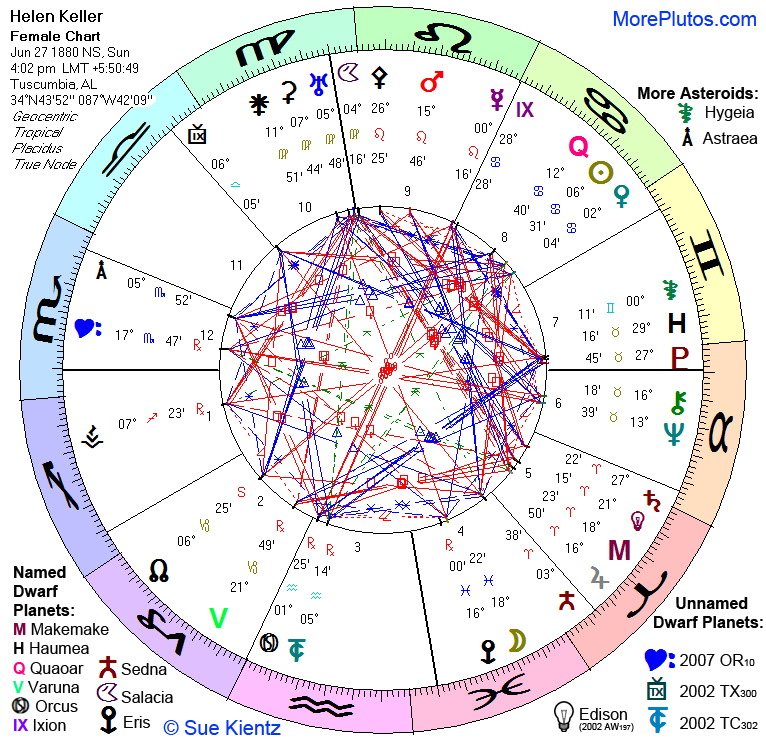|
Intro – The Myth
Zsuzsanna Griga
 Here is the second Dwarf Planet1 we offer for your enlightenment, Salacia. Here is the second Dwarf Planet1 we offer for your enlightenment, Salacia.
When a new celestial object is spotted and named, it becomes inherent in the world psyche, and we become aware of the synchronicity and how these objects become familiar to the peoples of the world. (Whenever you name something new you give it a destiny, which is going to be reflected back upon you.) Thus the new dwellers of the Solar System, the Centaurs (inner Kuiper-belt objects), the TNOs (Trans-Neptunian Objects) and the SDOs (Scattered Disk objects) are becoming important delineation tools for those willing to work with them. Centaurs receive their names from Ovid’s Metamorphoses, while TNOs and SDOs are named after creation gods and goddesses. Their astrological delineation is usually linked to their mythical stories, and the sign and astrological degree of their discovery (for example, any fixed star or outer planet on that degree at the time) may provide us with further insights.
Let’s take a closer look at Salacia, discovered on September 22, 2004 at Pisces 13°58. Its orbital period is 270.84 years, and it was categorized as a classical TNO, as its orbit lies beyond Neptune. In Transcendental Karmic Astrology, centaurs and Trans-Neptunians describe karmic wounds as well as the knowledge and insight that can be derived from wounding experiences. In Roman myths, Salacia (her name deriving from the Latin sal – salt) is one of the Nereids or water nymphs who ruled salt water. According to Karl Kerenyi, such titles as “titan,” “titaness,” “nymph,” or “nurse” in Greek and Roman mythology were given to outdated gods and goddesses no longer in power, so we may presume that before Zeus’ era Salacia was equal to Thetis, the ancient sea goddess. When Zeus (Jupiter) divided the world between his brothers and gave the oceans to Poseidon (Neptune),  Salacia continued to rule the dark ocean bottoms and salty waters. Neptune fell in love with her and intended to marry her, but Salacia got scared and hid from the sea god. Neptune sent a dolphin to find and persuade her to become his wife. Salacia eventually accepted his offer, and the grateful god rewarded the dolphin by elevating it into the night sky, immortalizing it as the constellation Delphinus. Salacia continued to rule the dark ocean bottoms and salty waters. Neptune fell in love with her and intended to marry her, but Salacia got scared and hid from the sea god. Neptune sent a dolphin to find and persuade her to become his wife. Salacia eventually accepted his offer, and the grateful god rewarded the dolphin by elevating it into the night sky, immortalizing it as the constellation Delphinus.
In some versions of the myth, Salacia became both Neptune’s wife and his queen, not just a happy ending but a subtle hint at a primordial concept. The combination of “wife and queen” can be found in several ancient mythologies, all of which refer back to matriarchal times. In the oldest cosmogonies, the world was created from chaos by a Goddess who emerged from nothingness, delivered a son, mated with him, and produced the next generation of gods and goddesses – together with everything else in the manifested world. In Egyptian myths, Isis was both the wife and the queen of Osiris, hinting at the fact that she actually ruled the Lord of the Egyptian Underworld. In Hungarian history, Our Lady the Virgin Mother (who today is generally identified with Mary, mother of Jesus, but who is the vestige of the primordial Creator Goddess) is not only our patron saint, but our queen. This hidden undercurrent is easily traced in several ancient creation myths and folk tales, despite the fact that later patriarchal religions successfully did away with the sacred feminine and even managed to demonize it.
In Roman mythology Salacia was the protector of salt water and the wavy patterns of the ocean. Her Greek counterpart can be found in both Amphitrite and Thetis, while she is also linked to Aphrodite. The name “Salacia” became one of Aphrodite’s adjectives, hinting at her miraculous birth as she emerged from the ocean foams, and the adjective derived from it, “salacious,” truly describes the basic behavior of the love goddess. This is an interesting twist if we consider the fact that when Neptune fell in love with Salacia, she fled because she wanted to save her virginity.
 Another relevant facet of the myth is that Salacia is quite successful in hiding from Neptune at the bottom of the oceans where the Sun’s beams are unable to penetrate – darkness is the territory of the Goddess, yet it is also very much part of Neptune’s domain. Let us ponder on this for a moment: why cannot Neptune find her himself? Does this mean that he is not familiar with his own territory? Could this be interpreted from a psychological viewpoint, the very fact that we are often completely unaware of what is hidden at the depths of our own psyche? The astrological delineation of Salacia should definitely consider these aspects as well. The celestial object had been spotted 71 times before its official discovery (the first photo was taken in 1982), which also hints at the concepts of “hiding” and “invisibility.” After their wedding, Neptune retained power over the surging seas, while Salacia received rulership of the sunny, calm surfaces; she was also linked to hot springs with high mineral content by the Romans. Another relevant facet of the myth is that Salacia is quite successful in hiding from Neptune at the bottom of the oceans where the Sun’s beams are unable to penetrate – darkness is the territory of the Goddess, yet it is also very much part of Neptune’s domain. Let us ponder on this for a moment: why cannot Neptune find her himself? Does this mean that he is not familiar with his own territory? Could this be interpreted from a psychological viewpoint, the very fact that we are often completely unaware of what is hidden at the depths of our own psyche? The astrological delineation of Salacia should definitely consider these aspects as well. The celestial object had been spotted 71 times before its official discovery (the first photo was taken in 1982), which also hints at the concepts of “hiding” and “invisibility.” After their wedding, Neptune retained power over the surging seas, while Salacia received rulership of the sunny, calm surfaces; she was also linked to hot springs with high mineral content by the Romans.
 Besides the fact that Neptune is unable to find her in his own domain, the myth provides a few other delineation potentials. The depths of waters have always been the territory of the Goddess, and remained so in patriarchal times as well. From this viewpoint, Salacia may be interpreted as the feminine side of Neptune, which is able to hide even from himself — a very Neptunian concept. Something similar occurs in the human psyche: we often hide our darkest aspects from ourselves and don’t allow them to the surface; otherwise we couldn’t act out our bright and sunny personality traits too convincingly for others. Neptune rules both the personal and the collective unconscious, as well as the primordial soul pool where the individual self is non-existent. Salacia was discovered in Pisces, Neptune’s own sign, which teaches us that all souls are one, and separation is only the illusion of our 3-D reality.
Besides the fact that Neptune is unable to find her in his own domain, the myth provides a few other delineation potentials. The depths of waters have always been the territory of the Goddess, and remained so in patriarchal times as well. From this viewpoint, Salacia may be interpreted as the feminine side of Neptune, which is able to hide even from himself — a very Neptunian concept. Something similar occurs in the human psyche: we often hide our darkest aspects from ourselves and don’t allow them to the surface; otherwise we couldn’t act out our bright and sunny personality traits too convincingly for others. Neptune rules both the personal and the collective unconscious, as well as the primordial soul pool where the individual self is non-existent. Salacia was discovered in Pisces, Neptune’s own sign, which teaches us that all souls are one, and separation is only the illusion of our 3-D reality.
A dolphin participates in this mythology. In the Neptune–Salacia myth, the dolphin yet acts as the keeper of a secret, thus the celestial body may be linked to hidden, forbidden, or even dangerous knowledge.
Another point of interest is the fact that once Salacia becomes Neptune’s wife she no longer rules the dark, hidden recesses of the ocean; instead, she becomes the queen of the calm, sunlit water surfaces and hot springs – which are masculine principles of nature, just like sunshine, heat, spring water, light, and clear visibility. What can be gleaned from this change? Darkness and depth are the prerequisites of the Goddess in her full powers. The keepers of the new masculine paradigm tried to demonize everything that symbolized the primordial feminine because they hoped to stabilize their own value system. In a way, this shift also occurs in the story: Salacia is allowed to leave the territory of darkness and may “rise” to the glittering surface.
Planetary Salacia’s Position Combined with Myth Leads to Meaning
Sue Kientz and Steve Tuffill
Strategies to Identify Meaning
How does one approach determining the significance of a new planetary body?
There are a number of ways. One could rely on the myth of the object’s name, and look at individuals or event that are representative of details of that myth. But which symbolic details will end up being helpful? With Uranus, the primordial Greek father-god’s role as a sky god is perhaps the only clue that planet Uranus would represent logic, sciences, aviation, and higher mind, all “air” qualities. No other part of this cruel god’s behavior or epic castration story apply to our understanding of Uranus’s function in charts; for example, there are no machines or mention of freedom and independence. Similarly with Neptune, only its connection with the sea hints that we’re dealing with mystery, connectedness, and hidden emotional depth. Astrologers were “on their own” to connect Neptune with spirituality, drug and alcohol abuse, film, photography, and deception.
One thing that astrologers obviously assumed is that Uranus might be an anti-Saturn force,
as it orbited farther from that farthest naked-eye planet. Noting so many “opposites” in the solar system (Sun/Moon, Venus/Mars, Saturn/Jupiter), perhaps that assisted in coming up with Revolution versus Status Quo, or the Individual versus the State. When Neptune was discovered 65 years later and of very similar size to Uranus, how perfect to again think of the next planet out being an “opposite.” If Uranus is logical, Neptune might be spiritual. If Uranus is man-made machines, perhaps Neptune is all of nature, and so on.
Could orbital placement help us discern which part of the myth is relevant to finding Salacia’s core meaning, which would allow us to confirm that interpretation through historical examples? First it might be well to get a handle on how things are arranged in Salacia’s neck of the woods.
Salacia’s 271-year orbit lies between Pluto (248 years) and Haumea (284 years), around two-thirds closer to Haumea than Pluto. Both Pluto and Haumea move in “safe zones” with several mid-sized planetoids on either side, having collected in these zones because they are resonant areas that synch with the orbits of the much larger gas giants. The bigger planets’ gravity affects the smaller Kuiper bodies, so if the Kuipers aren’t in areas that put them “in tune” with one or more of the gas giants, those smaller bodies risk being thrown out of the system or into erratic orbits that could make them collide with other objects (something that Haumea experienced millions of years ago; large fragments of the original, larger Haumea include 2002 TX300 and other smaller orbs called the Haumeids).
To help you appreciate what this means, Pluto, Orcus (247.9 yrs), and Ixion (248.3 yrs) are in 2:3 resonance with Neptune, meaning that every time Neptune orbits the Sun three times (164.8 for one orbit, so 3 times = 494.4 years), Pluto, Orcus, and Ixion orbit twice (Pluto X 2 = 496 years; Orcus X 2 = 495.8 years; Ixion X 2 = 496.6 years). See how close the time it takes these Dwarfs to circle the Sun twice, compared to the amount of years it takes Neptune to orbit three times? That’s resonance! Pluto, Ixion, and Orcus have a stable home.
Haumea and its group (Varuna and Quaoar) are similarly resonant, but with different ratios. However, Salacia is not in a group or near any other planetoid close to its size. Is Salacia in a non-stable area? Far from it. Salacia’s orbit is not only stable, it’s not eccentric like Pluto and so many other Dwarf Planets, which have paths that range widely farther and nearer at different times of their “year.” It’s as if Salacia slipped into a “secret” spot that is unusually synched with the outer Gas Giants, one which, in fact, shows Salacia most in tune with Jupiter and Saturn:

Those familiar with my book More Plutos will recall similar tables there like the one above, showing the details of resonant relationships. Just as I demonstrated there using Pluto and the rest, Salacia has remarkable relationships with each gas giant, in that for each additional orbit, Salacia syncs rather closely with the next gas giant inwards. For every three orbits, Salacia syncs with Neptune’s rhythm; every four orbits, with Uranus’s faster pace; five orbits put it on time with Saturn; and six with Jupiter’s quickest tempo.
Also note that, similar to the myth, Neptune does not have a good “grasp” on Salacia. She is more “friendly” with Saturn and Jupiter. That suggests this object might be like Saturn and Jupiter in nature. How could Salacia be like polar opposites? Recall the nymph was faced with a powerful god proposing marriage (an overwhelming experience, like Jupiter can be, even if a “fortunate” proposal). Nevertheless, she withdrew (Saturn-like, resisting, protective, unwilling to risk).
Maybe she did not feel in Control (Salacia is not part of Pluto’s group, whose members are very much about Control and Manipulation), and she lacked the ability to change the circumstances she faced (Haumea is the Change, Create, and Transformation group). Instead Salacia hid and waited for the right time, the right offer. Salacia could represent waiting for the perfect opportunity (Jupiter) to achieve success (Saturn, success after patience and/or negotiation). That would be its optimal experience. In challenging or difficult aspect, we might expect some excess (Jupiter) of negativity (Saturn), perhaps related to feeling not in control or unable to change a situation or something deemed unsatisfactory.
One last interesting correspondence between physical Salacia and the myth: the surface of Salacia is quite dark, its “albedo” or reflectiveness very low compared to other Dwarf Planets.2 In other words, Salacia is not very visible, perhaps the reason this large (905 ±103 km in diameter) planetoid was not easy to spot in the vast depths of the Kuiper Belt. Neptune’s inability to find Salacia might be excused!
Historical Examples Validate Salacia
Paid for their Opinion
Critics are in a unique position related to art and performance. They do not produce talent or creative projects, so they have no control over the quality of movies, songs, or the artists involved. Once films and musical works are released, there’s no changing them. If one has Salacia prominent, this might be a real annoyance, but with one avenue of relief: you can air your opinion. This is what critics basically do: they complain (and sometimes praise) for a living.
Roger Ebert (June 18, 1942, Urbana, IL; 7 a.m. used), Mercury Rx (18 Gem 21) opposite Salacia (18 Sag 42). Best known as one half of “Siskel and Ebert,” two movie critics who appeared on television from the mid-1970s until Siskel’s death, Ebert was first hired as a movie critic in 1967, when his p. Venus (18 Gemini) opposed n./p. Salacia. Siskel and Ebert began their career together on the PBS show Sneak Previews on Sept. 4, 1975. Each wrote movie reviews at competing Chicago-area newspapers, and consequently were very competitive with one another, to put it mildly. Gene Siskel (January 26, 1946, Chicago, IL; 7 a.m. used) had Salacia (25 Sag 18) opposite Ebert’s Sun (26 Gem 36), and Ebert returned the annoying favor with his Salacia semi-square Siskel’s Sun (5 Aqu 59). Yet somehow the rivalry and chemistry worked itself out, eventually making the two great friends.
 Simon Cowell (Oct. 7, 1959, Lambeth, England; 7 a.m. used), Sun (10 Lib 13) square Salacia (12 Cap 36). A former music executive turned reality-show judge, Cowell has made a fortune bandying about his signature critical remarks towards contestants on UK’s Pop Idol, American Idol, X-Factor, and Britain’s Got Talent. In other words, Cowell uses his hyper-critical personality and biting comments as a key feature of his job (square angle forces the energy to “work” for him).
Simon Cowell (Oct. 7, 1959, Lambeth, England; 7 a.m. used), Sun (10 Lib 13) square Salacia (12 Cap 36). A former music executive turned reality-show judge, Cowell has made a fortune bandying about his signature critical remarks towards contestants on UK’s Pop Idol, American Idol, X-Factor, and Britain’s Got Talent. In other words, Cowell uses his hyper-critical personality and biting comments as a key feature of his job (square angle forces the energy to “work” for him).
Edward R. Murrow (April 25, 1908, Greensboro, NC; 7 a.m. used), Mercury (21 Aries 36) opposite Salacia (21 Lib 38); American journalist and host of See It Now. Murrow was an excellent journalist and successful in early television, but he risked all of that by daring to publicly criticize the powerful Wisconsin Senator Joseph McCarthy during the Red Scare of the early 1950s. No one, not even President Eisenhower, had figured out how to stop the numerous, reputation-killing accusations of McCarthy, who constantly claimed there were communists in the U.S. State Dept., in the Army, in Hollywood, and elsewhere in positions of power. Murrow decided to take on McCarthy by devoting an entire show on exposing McCarthy’s tactics and statements.
On the day of the broadcast, March 9, 1954, Murrow’s p. Sun (19 Gem 02) was trine p. Salacia (20 Lib 49), and transiting Salacia (7 Cap 34) was trine Murrow’s natal Sun (4 Tau 51). Most of Murrow’s viewers had never seen McCarthy in action, and were shocked to see clips of his manipulative behavior and how often he contradicted himself. This was the beginning of McCarthy’s downfall and led to his censure by Congress in December of that year. Murrow critiqued McCarthy at the perfect time, and helped end one of the most shameful periods of U.S. History.
Politic Choices
When you’re in politics, you can’t always tell the truth. It’s often unwise to air your grievances or complain when in the middle of jockeying for power. Would Salacia show up at such times, when keeping quiet was necessary, in order to find the right time for action?
Benjamin Franklin (Jan. 17, 1706 NS, 10:30 a.m., Boston, MA), Sun (27 Cap 11) conjunct Salacia (5 Aq 33). While in England negotiating with Parliament for the American colonies, Ben Franklin sent some sensitive letters back to Boston, hoping they would give Samuel Adams and other Massachusetts activists information about what their governor was doing behind their backs. Leaking the Hutchinson Letters, however, was a big mistake, as Adams published them against Franklin’s wishes. Eventually Franklin’s involvement became known, and he was hauled before the King’s Privy Council on Jan. 29, 1774, as his p. Sun (5 Ari 32) sextile p. Salacia (7 Aq 13). As the solicitor-general ranted and raved at Franklin, the latter spoke not a word, but purposefully remained calm and collected. 3
Franklin (along with the entire Continental Congress) finally felt free to express their unadulterated opinion of British treatment of the colonies in the Declaration of Independence (July 4, 1776), as Franklin’s p. Sun (7 Ari 56) more closely sextiled p. Salacia (7 Aq 16).
Adolf Hitler (April 20, 1889, 6:30 p.m., Braunau am Inn, Austria), Sun (0 Tau 48) sesquiquadrate
Salacia (18 Vir 23); Venus Rx/Mars (16 Tau 22/16 Tau 41) trine Salacia. During the Sudetenland crisis, as Hitler kept up the pressure against British Prime Minister Neville Chamberlain and his allies, William Shirer wrote in his diary that on September 22, 1938, der Fuhrer became wild with anger when some turn of events had not gone his way. Specifically, Hitler fell on the floor and chewed the carpet,4 as his p. Sun (18 Gem 27) squared Salacia (18 Virg 04). Certainly he could not vent his frustration publicly for fear of upsetting his plans, but his fury had to go somewhere.
Donald Trump (June 14, 1946, 10:54 a.m., Jamaica, NY), Sun (22 Gem 55) opposite Moon (21 Sag 12)/Salacia (24 Sag 57). In his recent run for U.S. president, Donald Trump has, perhaps understandably, been critical of the current administration, the state of the U.S. economy, and the country’s standing in the world. Understandably, as he is arguing that he can do better. But along with the usual reasons, Trump has taken the unusual step of hurling very pointed and personal insults at his rivals, as well as towards members of his own party, minority groups, and anyone whom he feels is against him, including a federal judge overseeing a lawsuit against one of Trump’s businesses. It’s interesting to note, however, that his rival Hillary Clinton (Oct. 26, 1947, 8:02 a.m., Chicago, IL), has Moon (22 Pisc 51) square Salacia (25 Sag 43), which combines into a T-square with Trump’s Sun/Moon/Salacia. The U.S. electorate can already see that this will be a punishing campaign of hyper-critical proportions.
Salacia and U.S. History
If accurate, this meaning for Salacia of judicious delay of speech or action, or the inability to wait, should also pan out in mundane transits. Here are a few from the American history books for your consideration:
Salacia (9 Lib 41) square U.S. Sun (12 Can 43) — On Sept. 8, 1901, President McKinley is shot, then succeeded by Vice President Teddy Roosevelt, who just five days before first publicly mentioned his signature line, “Speak softly and carry a big stick.” Roosevelt would actually practice this careful aphorism in his dealings both domestic and foreign.
Salacia (28 Sco 22) sesquiquadrate U.S. Sun (12 Can 43) — The New York Stock Market Crash on Oct. 29, 1929, kicks off the Great Depression, causing immeasurable suffering and justifiable complaint.
Salacia (12 Cap 31) opposite U.S. Sun (12 Can 43) — Tybee Atomic Bomb Lost, Feb. 5, 1958. A 7600 lb. Hydrogen bomb was dropped into the waters off Savannah, GA, after a mid-air collision, but never recovered.5 One can only imagine Dwight Eisenhower hitting the ceiling when he was informed, but there was no way the U.S. government could admit to this terrible accident for many years.
Salacia (26 Aq 44) sesquiquadrate U.S. Sun (12 Can 43) — During a state dinner on Jan. 8, 1992, President George H.W. Bush became suddenly ill and vomited into the lap of the Japanese Prime Minister. An almost classic example of being unable to hold back until the proper or appropriate time.
Salacia is currently at 0 Aries. We have nine years to go before Salacia approaches the next challenging aspect to the U.S. Sun. So beginning in 2025, we must be very careful to hold onto our bombs and keep the Pepto-Bismol handy....
Of Course, There's More to Know
Salacia obviously doesn’t just apply to those who become critics or politicians, but is meaningful in every chart, even if it might not be making angles with one’s personal planets, Ascendant, or Midheaven. After all, this analysis is intended just to get you started, so you can help add to the understanding of Salacia using your own experiences.
I confess that as I was working on this topic, I did what I’m sure all astrologers would do – I put Salacia in my own chart to see what I would find. I wasn’t sure what to make of my Sun opposite Salacia, but when I ran secondary progression, the “waiting to talk or reveal” idea seemed validated. You see, before my book was published, the Eris chapter of More Plutos was excerpted in the Astrological Journal. That issue arrived in the mail on Sept. 2, 2014, when my p. Sun (7 Vir 04) trined p. Salacia (7 Cap 00). The time had come when I could openly talk about my theories on the Dwarf Planets, as I had held back until I had it in print.6
The Dwarf Planets in the Kuiper Belt detail different ways to respond to chaotic dilemmas, external or internal.
Out past Neptune is the “Wild West” of our experience, and Pluto, Haumea, Makemake, and others are different responses to being insecure, marginalized, outcast, and out of the mainstream. But note that Salacia’s solution is not fully implemented unless the person not only withdraws, but finds a way to accept opportunity after the withdrawal. It might feel good to just “play it safe,” but remember that Salacia’s most resonant relationship is with Jupiter. You have to open back up!
 To make this last important point, consider Helen Keller (June 27, 1880, 4:02 p.m., Tuscumbia, AL), born with Salacia (4 Vir 16) conjunct her Midheaven (5 Vir 00). At age 2, an illness left her deaf and blind, and for years she was cut off from the world, in enforced “withdrawal.” Only through the agency of another person (her “dolphin”), teacher Annie Sullivan, was she able to learn that all around her lay meaning, that people and objects had names, intent, information. But she didn’t stop there. Keller insisted on going to college, even as during that time, few women did so, and no one who was blind and deaf ever had attempted such a thing. But Helen wasn’t just gathering information, she was dispensing it. During college she wrote her life story, then later hit the lecture circuit with her companion, traveling all over the world to tell people that they, too, can do whatever they want with their life, no matter their situation or limitations. She made it her life’s work (Salacia at Midheaven) to "accept Neptune's hand" so as to touch and inspire others, everywhere.
To make this last important point, consider Helen Keller (June 27, 1880, 4:02 p.m., Tuscumbia, AL), born with Salacia (4 Vir 16) conjunct her Midheaven (5 Vir 00). At age 2, an illness left her deaf and blind, and for years she was cut off from the world, in enforced “withdrawal.” Only through the agency of another person (her “dolphin”), teacher Annie Sullivan, was she able to learn that all around her lay meaning, that people and objects had names, intent, information. But she didn’t stop there. Keller insisted on going to college, even as during that time, few women did so, and no one who was blind and deaf ever had attempted such a thing. But Helen wasn’t just gathering information, she was dispensing it. During college she wrote her life story, then later hit the lecture circuit with her companion, traveling all over the world to tell people that they, too, can do whatever they want with their life, no matter their situation or limitations. She made it her life’s work (Salacia at Midheaven) to "accept Neptune's hand" so as to touch and inspire others, everywhere.
Image above is Helen (left) and her teacher Annie Sullivan.

Helen Keller Chart:
Note Salacia at the Midheaven. This original glyph for Salacia represents a person with uplifted head, ready to speak, but holding back. The eyes are closed to represent the desire for patience and the ability to wait to the right moment. The hope is that this icon for Salacia will more easily remind the astrologer (and client) of the significance of Salacia. Glyph design: S. Kientz.
Hopefully you will feel that now is the time to try out Salacia in your own charts.
There is an online Salacia ephemeris to get you started. If you’re on Facebook, come share your observations on Steve Tuffill’s Astro Discussion Group. To join the group, email Sue Kientz.
Keywords:
Hesitant, perfect timing, gushing, bad timing, judicious delay, inability to wait, indiscreet talk, can’t keep a secret, gentility and familiarity with decorum and poise.
All birth data is either from astro.com (those with time of birth) or Wikipedia.com (no time of birth; 7 a.m. used).
All photos and artwork (save for the Helen Keller wheel chart) are from Google images and free for all use.
End Notes
1. Last month we looked at Makemake
2.
http://www.planetary.org/blogs/emily-lakdawalla/2012/06261021-salacia.html
3. http://www.publicbookshelf.com/public_html/Our_Country_vol_2/benjaminf_de.html
4.
https://furtherglory.wordpress.com/2011/12/21/adolf-hitler-the-carpet-eater-teppichfresser/
5, http://www.alternet.org/story/140060/the_case_of_the_missing_h-bomb%3A_the_pentagon_has_lost_the_mother_of_all_weapons
6. This observation was made after I had already formed the "judicious waiting for prime opportunity” theory of Salacia
Previous Plog post: May Dwarf of the Month: Makemake
Return to the Plog
|

